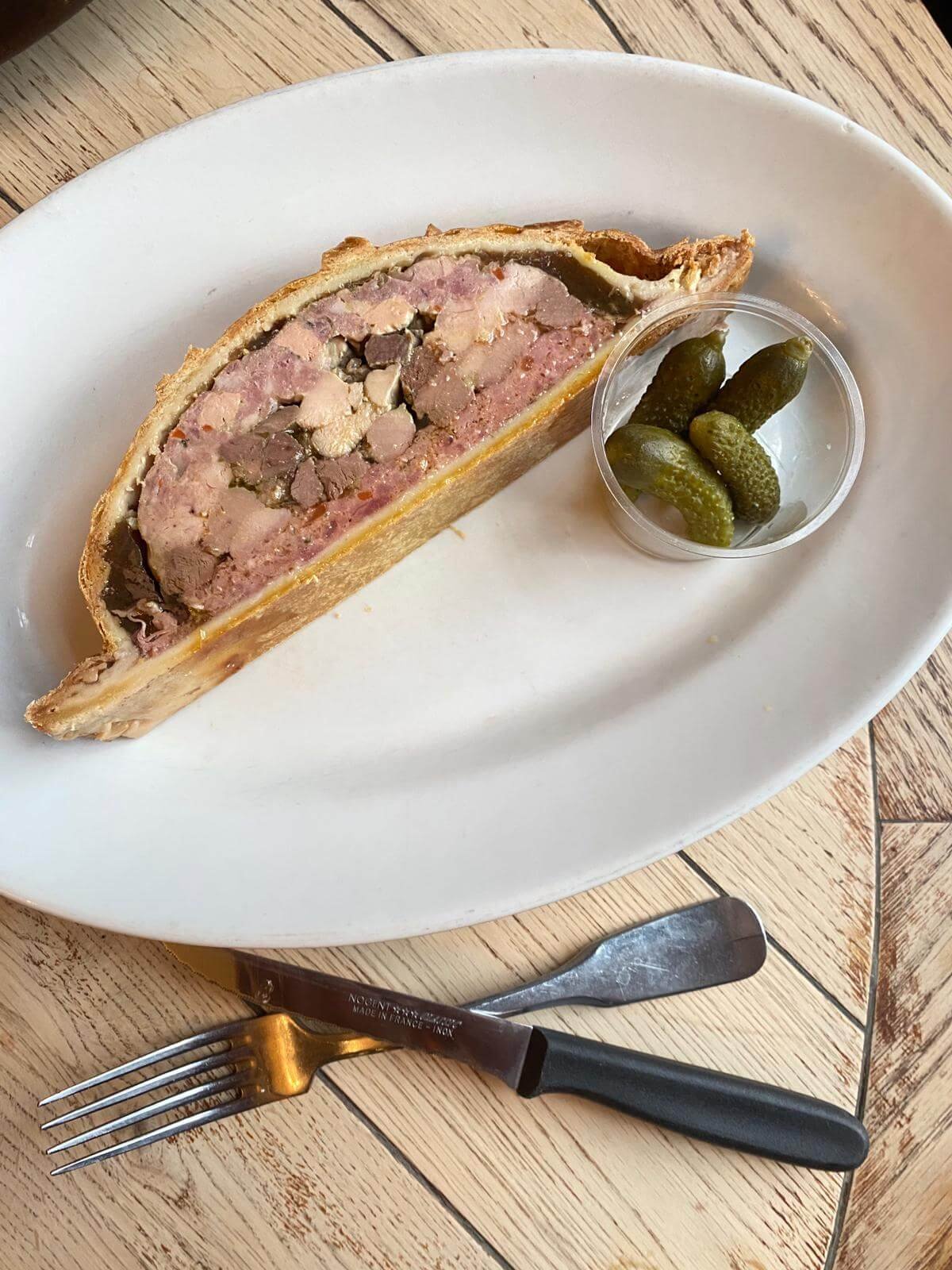Fred's newsletter 19.1.21
L’oreiller de la belle Aurore - it turned out well!
Good morning,
Jambon au gratin, endive au jambon, chicon-gratin, gratin d’endive béchamel, roulade d’endive au fromage: these are some but not all of the names for a classic dish we all enjoyed (or not) as a youngster at home or at the canteen. It’s one of those dishes that the nostalgic, like me, will love. It’s a dish from the north of France, travelling to Belgium and Holland, made with the wiltloof or chicory endive that’s slightly neglected, or just appears as a leaf on the side of the plate. Its bitterness doesn’t help its reputation I suppose. It can be eaten raw, usually with a cheese of some kind and walnuts, but when cooked au gratin along with ham made and cooked in house, using an organic pork leg from somewhere like Peelham Farm, along with a béchamel sauce made using organic milk, then topped with cheese from Mons cheesemonger, then you are guaranteed a healthy and tasty meal. Did you think for a minute that I would use ham from a wholesaler or supermarket? Mais non! Having read and understood all that goes into a factory ham it might be a long time before I personally have any. Simplicity of a meal is primordial, as is provenance to guarantee healthy nutrition. Our job as restauranteurs is to uphold both.
I thought I would compliment myself this morning. Last week was a very stressful one. I put the game pie on the menu having never done one of that type before, in the Oreiller’s way, and I had no idea if it would stay up, cook well, or even be presentable! Friday morning was even more stressful when it was time for Bertrand and I to cut the first slice. Once we had seen the inside, whoa, whoa what a relief! What we could see was a well-presented and cooked pie, pink inside and smelling like a dream. I really hope you enjoyed that pie.
Whilst making that pie and other things, we cooked the ham for this week’s menu: a whole leg, boned out before spending a few days in a brine. That ham had been in my mind for a few weeks before getting round to it. See picture below. I hope you will like it with the chicon.
This week’s menu, apart from the endives, sees another pie as a starter, this time with pork, lamb tongues and pistachios, served with a mayonnaise gribiche sauce. It’s taken me weeks to accumulate enough tongues, given to us by our friend Jack at Ardoch Farm each time we got a Hebridean lamb delivery. It took 6 month to amass about twenty!
The fish soup and crab bisque is replaced by a Shetland mussel bisque thickened with cream. This subtly flavoured soup will be accompanied by an aioli, croutons and grated cheese, tasty. Trust me. The snails this week are joined by chorizo, still with garlic and parsley though. And the beetroot salad is back, served with Tomme de Chambrouse, a light fresh goat’s cheese, and a coarse grain mustard vinaigrette.
On the mains, there’s boeuf Bourguignon using shin and brisket. The beef this time is from Hardiesmill in the Borders. Some of the best beef in the world people say - all Aberdeen Angus. I will share a few lines from owner Robin Tuke’s website (this is enough for me to trust them and want to use that beef, below there are more details): “Feeds affects flavour, taste point, juiciness, water content, texture and nutritional values. We use grass in the summer, hay, grass silage and straw in the winter, no concentrate, no hormones, no steroids, hence the tremendous impact of the terroir here on the flavour of the beef. It’s light on the front of the tongue, but big on the top and sides of the mouth, with amazing longevity of taste.” Robin’s beef is in the Slow Food ‘Ark of Taste’, there must be a good reason.
I’m working with a new duck farm in the South West of France, well we have been for a few months now. As there’s no duck to be found anywhere in Scotland (believe me, I have tried) it was easier to shop in France. You enjoyed some confit we made with it a few weeks back, it was a great product. This week, duck legs will be braised and accompanied with king oyster and chestnut mushrooms, and a sauce finished with an olive tapenade. A fine meal if you ask me.
We also have some beautiful East Lothian hogget from Jane Brand that we will cook ‘à la cuillere’ meaning ‘the spoons way’. Some menus will read: baked 24 hours, 7 hours, 12 hours, all meaning the same, basically until the meat falls apart using a spoon. It will be spend two days marinading in lots of rosemary, thyme, bay leaves, sea salt and olive oil, then off it will jump into the oven for…many hours! Then it will then be rolled and a strong lamb jus will join the meat.
The last meat main of the week is pork neck fillet from my friend Nigel at McCaskie Butchers. I will cook it like a casserole using cider instead of stock, then it will be finished with coarse grain mustard and honey. And finally, this week’s fish will be served with a sauce made of citrus and some light curry flavours. I am told we will get some beautiful fresh coley this week, making a change from cod.
Spinach was unavailable, like many vegetables. I won’t say much, you would have read the news: weather, Brexit, bla bla bla. Let’s not go there. We use Scottish vegetables as much as possible before selecting others from the continent.
Pears are still plentiful, so we have a wonderful pear and almond tarte for two. Also a thick duck egg crème caramel, and this week no less than three chocolate desserts! Chocolate is required in difficult times; it helps blood flow, lowers blood pressure, reduces heart disease, protects the skin, improves brain function, makes us smile, and generally makes our taste buds happy. The same applies to vanilla, we use it a lot of whilst making desserts.
Before I go, I want to introduce you to James Close who I met few years back. He is a good friend, great customer and also runs a fabulous restaurant in the North of England, the much-acclaimed Raby Hunt that holds 2 Michelin stars. James and his team are doing a fabulous job, please don’t hesitate to visit him whenever we go back to some kind of normality. I have asked him to write a few words for us on what makes a great restaurant (click here). Thank you James.
Finally, I realise that many of you are struggling to get in touch with us by phone to place an order. So please do not hesitate to email your order to us here: contact@lescargotbleu.co.uk. Make sure you include your full name and address, plus a contact telephone number, and we will call you back. This will save time and will take your frustration away. Just to be clear, we do not want to take orders from a website as we want to maintain some real-life relations with you.
I’ll also remind you that we do not wish to use a service like Deliveroo or anything else to deliver our food, there are too many reasons to list them all here. Last week we delivered to around 55 addresses, some in Edinburgh, and some a bit further afield. Ask us, we will do our best to satisfy your requests.
Thank you for your ongoing custom, your support and your kindness.
A bientôt,
Fred
HARDIESMILL - MASTERS OF MEAT
Hardiesmill is a boutique supplier of top-end beef, seen as one of the best in the world. We are Slow Food "Ark of Taste" and one of 15 "Masters of Meat" around the world. We strive for consistency, which is not easy with nature, so everything is pedigree Aberdeen Angus, is grass-fed all its life, and spends its entire life on the farm (we have a dedicated export-approved abattoir on-farm, the only one for cattle in the UK).
Welfare here is seen as some of the highest in the world and we should be carbon neutral as well as zero food-miles by the end of 2021. In short, we produce sustainably. Nutritionally this has benefits, as it reduces the calorific value of the beef whilst remaining high in: protein, Omega 3&6 (naturally balanced) and Vitamin B12.
We only produce approximately one hundred Hardiesmill carcasses a year, and won't buy in (as they have a different flavour) so restrict ourselves to our on-line and pop-up farm shops, plus very limited trade customer base, with whom we enjoy working closely.
Robin Tuke, partner at www.hardiesmill.co.uk
Tasting Notes for Hardiesmill Beef
The butchers at Hardiesmill seam-cut the beef in order to produce 16 different steaks: some prime, some textured and all with different flavours and textures. However common to all is that the taste of the Aberdeen Angus sits on the teeth and cheeks, whilst the time spent dry-ageing changes the impact on the mid-front top of tongue. The unique minerality of Hardiesmill (from the terroir here) comes in around the tonsils and back-of-throat on the second swallow.

